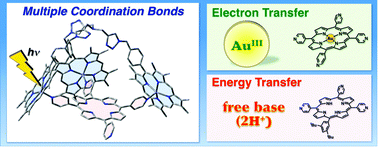Photodynamics in stable complexes composed of a zinc porphyrin tripod and pyridyl porphyrins assembled by multiple coordination bonds†
Abstract
A tripod zinc porphyrin (

* Corresponding authors
a
Department of Material and Life Science, Division of Advanced Science and Biotechnology, Graduate School of Engineering, Osaka University, Suita, Osaka 565-0871, Japan
E-mail:
fukuzumi@chem.eng.osaka-u.ac.jp
Fax: +81 6-6879-7370
Tel: +81 6-6879-7368
b
ICMUB, UMR CNRS 5260, Université de Bourgogne, 9 Avenue Alain Savary, BP 47870, 21078 Dijon Cedex, France
E-mail:
Jean-Michel.Barbe@u-bourgogne.fr
Fax: +33 3-80-39-61-17
Tel: +33 3-80-39-61-19
c Department of Bioinspired Science, Ewha Womans University, Seoul 120-750, Korea
A tripod zinc porphyrin (

 Please wait while we load your content...
Something went wrong. Try again?
Please wait while we load your content...
Something went wrong. Try again?
A. Takai, C. P. Gros, J. Barbe and S. Fukuzumi, Phys. Chem. Chem. Phys., 2010, 12, 12160 DOI: 10.1039/C0CP00329H
To request permission to reproduce material from this article, please go to the Copyright Clearance Center request page.
If you are an author contributing to an RSC publication, you do not need to request permission provided correct acknowledgement is given.
If you are the author of this article, you do not need to request permission to reproduce figures and diagrams provided correct acknowledgement is given. If you want to reproduce the whole article in a third-party publication (excluding your thesis/dissertation for which permission is not required) please go to the Copyright Clearance Center request page.
Read more about how to correctly acknowledge RSC content.
 Fetching data from CrossRef.
Fetching data from CrossRef.
This may take some time to load.
Loading related content
